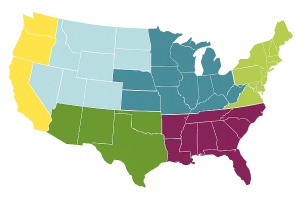USDA Hardiness Zone Map - Find Your Zone
Posted By American Meadows Content Team on Sep 27, 2012 · Revised on Oct 3, 2025

Knowing your location helps us recommend plants that will thrive in your climate, based on your Growing Zone.
Posted By American Meadows Content Team on Sep 27, 2012 · Revised on Oct 3, 2025

The USDA Plant Hardiness Zone Map (shown above) is a tool that can help you find the right plants. Knowing your zone is critical before selecting plants because it allows you to purchase plants that will survive the extremes of the summer and winter months in your climate.
Zones range from Zone 1 (coldest) to Zone 13 (warmest).
USDA zones are based on the average annual extreme minimum winter temperature. Each color represents average coldest temperature in 10°F zones. These zones provide a convenient way to communicate and compare the climates within the United States.
Did You Know? In late 2023, the USDA updated their Hardiness Zones based on 1991-2020 weather data - and they represent a trend in warming temperatures.
For more details, check out this interactive map from NPR with information about changing USDA zone designations.
Hardiness Zones
Growing Zones
For example, let’s look at Dahlia Hardiness Zones vs Growing Zones:
Frost dates are important for gardeners to know, as they signal the start and end of the gardening season. These charts can help you estimate when to expect the first frost in fall, and the last frost in spring.
See our guide: Frost Dates By USDA Zone
The USDA Plant Hardiness Zone Map (shown above) is a tool that can help you find the right plants. Knowing your zone is critical before selecting plants because it allows you to purchase plants that will survive the extremes of the summer and winter months in your climate.
Zones range from Zone 1 (coldest) to Zone 13 (warmest).
USDA zones are based on the average annual extreme minimum winter temperature. Each color represents average coldest temperature in 10°F zones. These zones provide a convenient way to communicate and compare the climates within the United States.
Hardiness Zones
Growing Zones
For example, let’s look at Dahlia Hardiness Zones vs Growing Zones:
Frost dates are important for gardeners to know, as they signal the start and end of the gardening season. These charts can help you estimate when to expect the first frost in fall, and the last frost in spring, so that you know when to plant in your garden or meadow.
See our guide: Frost Dates By USDA Zone
Your property is most likely not a “one size fits all” in terms of planting spots. Take a moment now to visualize all of the different microclimates you have. Some examples include:
There can be many microclimates on one property, or from neighbor to neighbor. Identifying your unique growing conditions is important for properly selecting plants. For example, within the same USDA zone, the plants that will thrive next to a pond versus a rocky hilltop will likely be different plants.
For in-depth details, visit the USDA Website. There, you can find a previous version of the map of USDA Zones from 2012-2023.